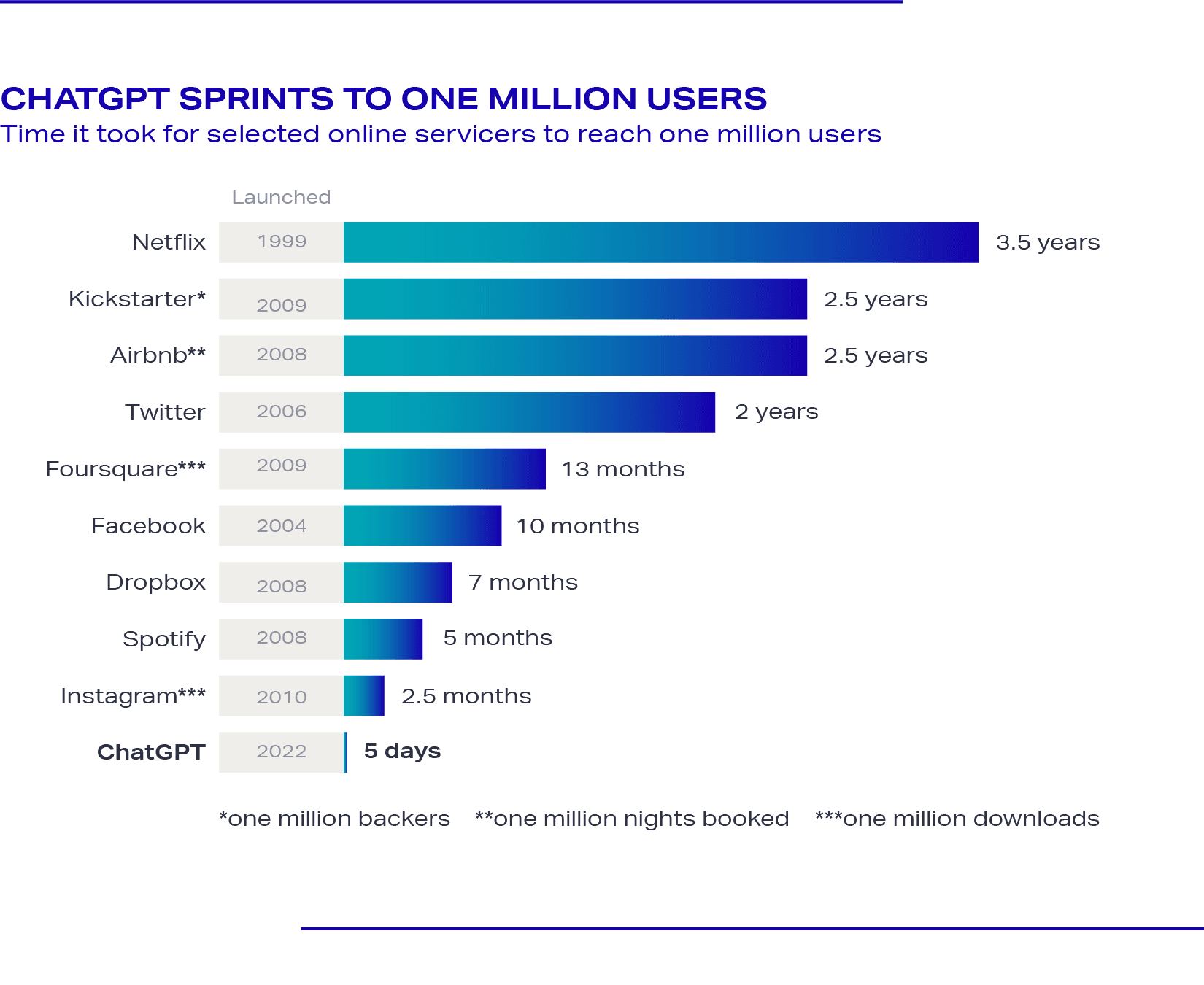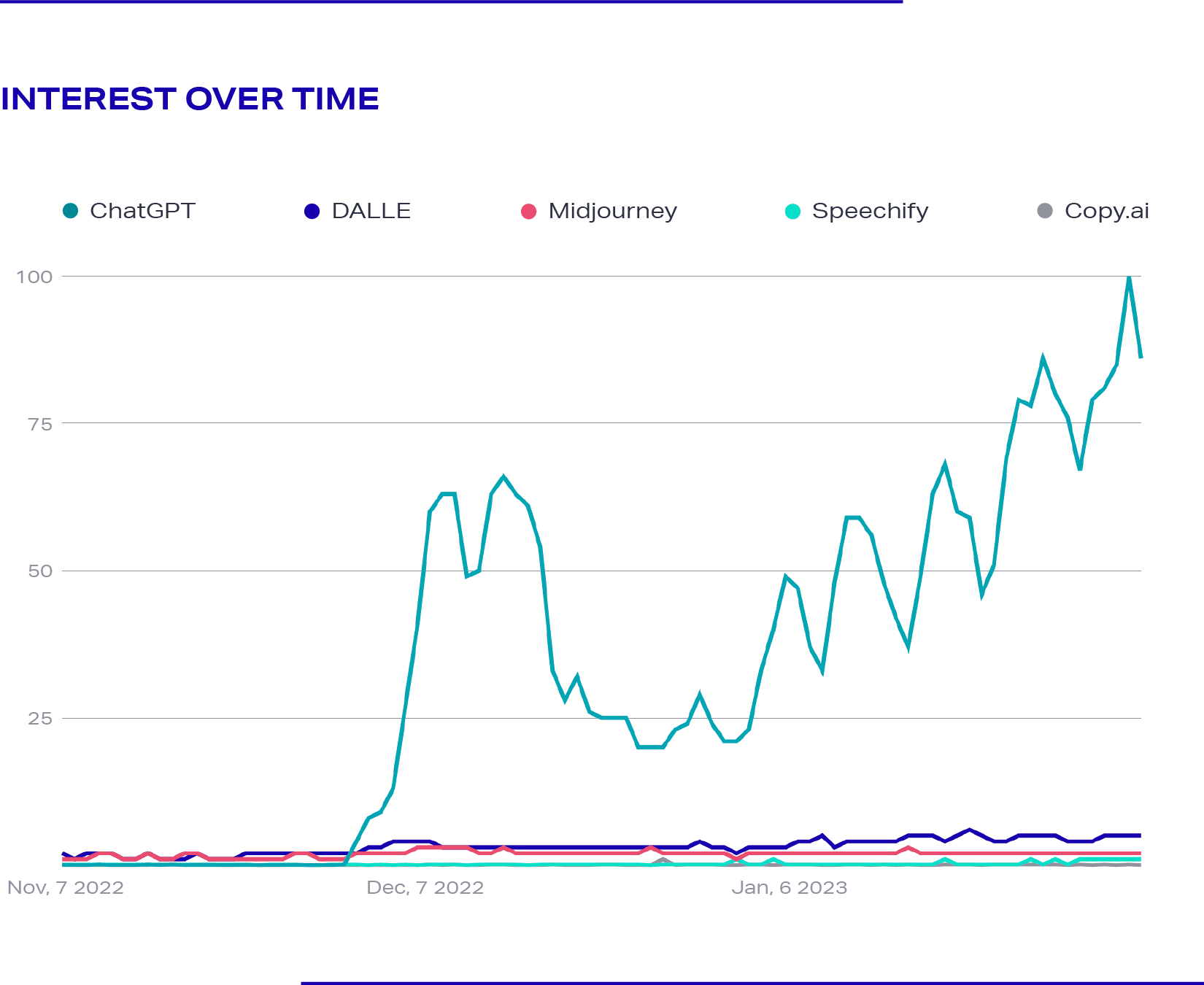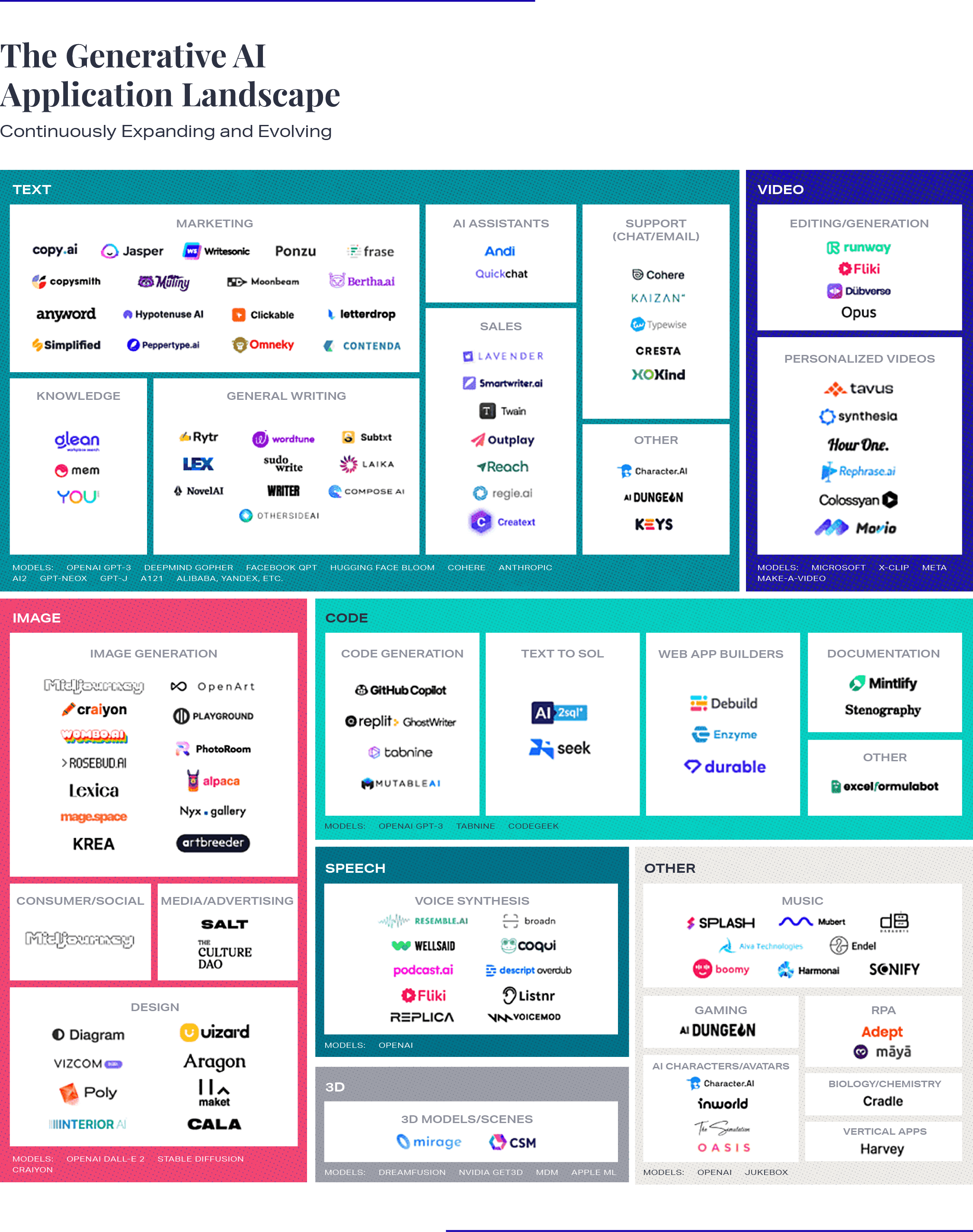Accessibility Tools
PMG Digital Made for Humans
The Limits & Endless Potential of Generative AI
February 9, 2023 | 4 min read
Abby Long, Senior Managing Editor
Abby manages PMG's editorial thought leadership program. As a writer, editor, and marketing communications strategist with over a decade of experience, Abby's work in showcasing PMG’s unique expertise through POVs, research reports, and thought leadership regularly informs business strategy and media investments for some of the most iconic brands in the world. Named among the AAF Dallas 32 Under 32, her expertise in advertising, media strategy, and consumer trends has been featured in Ad Age, Business Insider, Digiday, and The New York Times. She holds a Master's in Liberal Arts from Texas Christian University.
In recent months, artificial intelligence has moved to the forefront of the tech industry and digital ecosystem with the latest developments being Google’s announcement of Bard, its generative AI search and discovery product, and Microsoft formally integrating ChatGPT into the search experience on Bing. New applications, regulatory concerns, and partnership innovations are making headlines every day, as there are truly endless possibilities for what the future holds.
As the commercial capabilities of generative AI are just beginning to take shape, our latest POV explores the current generative AI landscape and how marketers can lean in and explore this evolving frontier.
Generative AI has captured the imaginations of nearly everyone, from business leaders and policymakers to marketers and technologists, with the latest generation of AI apps like ChatGPT signaling a new era in artificial intelligence. While chatbots and other AI assistants have been commercially available for years, recent advancements have supercharged the potential of this technology to revolutionize knowledge creation and productivity.
Generative AI refers to a new class of AI tools that utilize neural network models to generate content, such as creative writing, art, and coding, as well as manage general- purpose tasks. While the concept first formed nearly a decade ago, a recent wave of generative AI developments has accelerated more sophistication while lowering the costs associated with running such complex workflows. Combined, these trends enabled research labs like OpenAI and Stability AI to recently expand from closed to open betas (and even some open source tools), unlocking new opportunities for app development, creativity, and exploration.
“Microsoft CEO Satya Nadella dubbed early 2023 the 'ChatGPT moment.'”
It’s not uncommon for new apps and tech trends to get sensationalized by early adopters, however, generative AI is already seeing substantial growth, rapid adoption and real traction. OpenAI reigns as the current market leader of generative AI technology, thanks to its first-to-market products DALLE-2 and ChatGPT. Within five days of its release in November 2022, ChatGPT reached one million users.

Consumer interest in OpenAI’s ChatGPT shows no signs of slowing down and demonstrates true staying power, having eclipsed all other popular generative AI apps and tools to date. As shared by Box CEO Aaron Levie in a tweet, “There’s a certain feeling that happens when a new technology adjusts your thinking about computing. Google did it. Firefox did it. AWS did it. iPhone did it. OpenAI is doing it with ChatGPT.”
Further Reading: Generative AI Steals the Show at 2023 World Economic Forum

Generative AI will become even more mainstream as tools like ChatGPT dominate headlines and industry discussion. Already, Microsoft CEO Satya Nadella dubbed early 2023 the “ChatGPT moment.”
Just this week, Google announced Bard, a new generative AI search and discovery product that is entering a closed beta and will become more widely available to the public in the coming weeks. According to the blog post announcement, “Bard seeks to combine the breadth of the world’s knowledge with the power, intelligence and creativity of our large language models (LLM). Itdraws on information from the web to provide fresh, high-quality responses.” Bard will soon integrate into Google Search, with AI features on the search results page helping to “distill complex information and multiple perspectives into easy-to digest formats.” Similarly, Microsoft officially announced ChatGPT will integrate seamlessly into the Bing search experience, helping users harness the power of ChatGPT directly on search results pages.
“AI is the most profound technology we are working on today. — Alphabet CEO Sundar Pichai”
Generative AI is poised to deliver trillions of dollars in economic value as new applications of generative AI models burst onto the scene and expand how technology plays a role in people’s lives. It’s difficult to quantify the impact generative AI has had—and will continue to have—as the underlying technology stack grows more sophisticated. Already, a host of apps, assistive technologies, and task managers have launched, with most built upon the same language learning models powered by the likes of OpenAI, Stability AI, and Hugging Face.

As adoption grows and new entrants emerge to capitalize on this evolving frontier, every day brings more advancements and creative opportunities, alongside new challenges. Amid the excitement of these groundbreaking technologies, experts in the field and early adopters have raised questions about its potential to replace human creativity alongside concerns for the trustworthiness and the legitimacy of autonomous creative production. Since many of these apps and neural network models are in open beta, we’ll continue to see new feature rollouts in the months to come as researchers and the general public pressure-test these systems with real-world applications.
Won’t Approximate Human Intelligence: There is clear consensus among researchers across the discipline that while the natural language outputs by LLMs and generative AI apps appear to approximate human intelligence, these systems don’t have the ability—or capacity—to replace humans.
In terms of written content, OpenAI recently released an AI Text Classifier to better understand if, and under what circumstances, AI-generated content can be detected. It’s also important to note that AI-generated content is considered spam under Google Webmaster Guidelines.
Exists in a Legal Gray Zone: The language models and neural networks that power generative AI are built by effectively scraping hundreds of gigabytes of information from the internet then training the model to infer and predict what information should be used to create an output from a prompt. Already, creators and companies like Getty Images have filed legal complaints against research firms Midjourney and Stability AI for scraping content without the consent of original artists, acting in violation of copyright law.
Content Ownership Remains Unclear: Until there are clear legal frameworks for identifying content ownership—and as active complaints wind their way through the legal system—there’s an increased risk of copyright infringement by using AI-generated art and imagery for commercial purposes like advertising.
Outputs Can Be Inaccurate: A quick search of social media will surface countless examples of how generative AI tools delivered erroneous information despite expressing a tone of certainty. Early applications by CNET for ChatGPT to produce written news articles for the newsroom quickly ended after fact-checkers determined the AI-generated content was inaccurate.
Who owns AI-generated content? Who’s responsible for its accuracy? How does the industry eliminate bias, misuse and ensure ethical applications? Answers to these questions are unclear or largely depend on the generative AI platform in use. Midjourney’s terms of service, for example, state that the user owns all assets created with Midjourney, although Midjourney has broad license to use AI-generated images as well as the text prompts used to generate the images.
So far, some of the most popular marketing-related applications for generative AI have been used to power:
Copy and content creation: Tools like Jasper AI and Writer provide copy templates to help generate product descriptions, FAQs, script writing, closed captioning, and creative messaging ideas.
Code generation: No-code web solutions are nothing new, but plenty of code generation AI models have been introduced to build simple landing pages or web app environments, construct design layouts, and more.
Art and 3D models: Art and image generation from the likes of Midjourney and DALLE-2 can be used to help accelerate creative ideation.
Like any emerging technology, as the field of generative AI continues to evolve, regulation won’t be far behind. Already, European lawmakers are drafting legislation to ensure more responsible use of generative AI. While recent advancements are impressive in their own right, generative AI technology has a long way to go before being capable of unsupervised autonomous creative production of content in any form.
Final Thoughts
Marketers, Lean In and Explore Generative AI
There are truly endless possibilities for what the future holds for generative AI as its commercial capabilities are just becoming clear. As with any exciting innovation, we encourage marketers to lean in and test generative AI tools to better understand their current capabilities—and take note of their limitations. Material from generative AI models may supplement human creativity with idea generation or process automation, but any output will always need to be carefully reviewed for accuracy and quality by trusted experts.
The bottom line is that when put to use in good faith, generative AI enables an exciting future for marketers where tedious processes can be automated, and knowledge creation as well as productivity can be enhanced by technology, helping people focus their time and creativity on solving challenges and creating what’s never been done before.
Generative AI is evolving fast.
Lean in and test the capabilities—and limitations—for generative AI applications.
Exercise caution when using AI-generated content for commercial uses.
